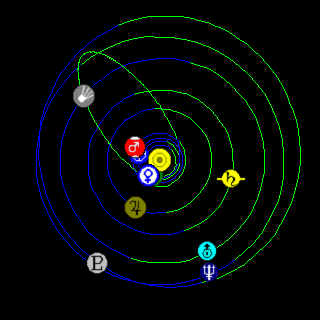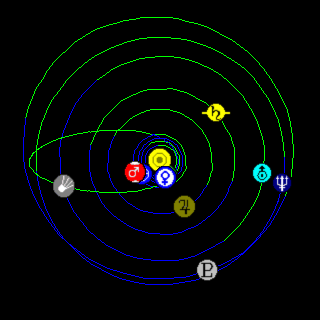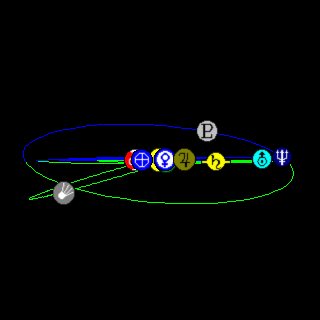 Solar System Live Help
Solar System Live Help Solar System Live Help
Solar System Live HelpYou can view the solar system from any three-dimensional vantage point to better visualise orbital inclinations. By default, Solar System Live shows a “plan view” of the solar system—the view from directly above the Sun's North pole (heliocentric latitude 90° North). Smaller values in the heliocentric latitude box produce more oblique views of the solar system. Checking the “South” box produces views from below the plane of the ecliptic, looking toward the southern hemisphere of the Sun.
The heliocentric longitude rotates the solar system with respect to your viewpoint—you can, for example, put the Earth in the front of an oblique display to see which planets are in conjunction and opposition more easily.
For example, here's a view of the solar system with Halley's comet plotted by specifying its orbital elements.

The viewpoint is the default:
As described in the help for Orbit Plotting, Halley's Comet's appearing on the green portion of its orbit indicates the comet is below the plane of the ecliptic (the plane defined by the orbit of the Earth). Pluto, on the other hand, is on the blue portion of its orbit, indicating that planet is above the plane of the ecliptic.
Using the Heliocentric latitude and longitude controls, we can change the viewpoint to make this more evident. First, let's set the longitude to “turn” the solar system so the orbit of Halley's comet points to the left. Setting the longitude to 305° does the trick:

This also brings Pluto to a convenient position at the front. Now, to show the inclination clearly let's rotate the solar system so the ecliptic is edge-on. To do this, change the heliocentric latitude from 90° (above the north pole of the Sun) to 0° (in the plane of the ecliptic, looking at the Sun's equator).

This viewpoint clearly shows the positions, above and below the ecliptic, respectively, of Pluto and Halley's Comet. It's also evident from this viewpoint that the other planets orbit very close to the plane of the ecliptic.
Choice of a suitable heliocentric viewpoint, especially in conjunction with stereoscopic viewing, makes it much easier to visualise the path through the Solar System of comets with highly eccentric and/or inclined orbits.
Return to Solar System Live Other Help|
|